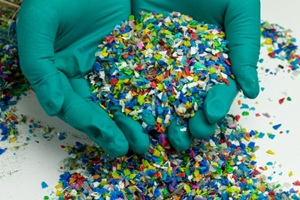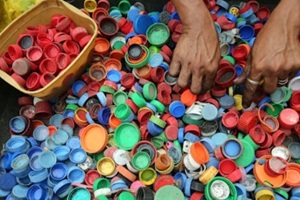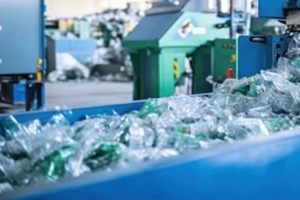May 26, 2025

Mixed plastic waste, especially from polyesters PET, PLA, and PBAT, has long presented a challenge for recyclers due to its chemical diversity and end-of-life incompatibilities. As pressure grows for scalable and sustainable alternatives, chemical plastic recycling, particularly methanolysis, offers a promising path forward.
Bio-based polyesters such as PLA and PBAT are gaining significant traction in packaging and compostable applications, with market projections forecasting increased adoption across multiple sectors. These materials are expected to represent a larger share of the overall plastics stream in the coming years, presenting both a challenge and an opportunity for waste recovery systems.
Economic modeling shows methanolysis has a substantial advantage in this space, reducing the minimum selling price of recycled polyester materials by 31% compared to virgin equivalents.
Methanolysis consistently outperforms other methods of chemical plastic recycling, glycolysis, and acid hydrolysis, across economic and environmental criteria.
Among the three, methanolysis delivers the lowest minimum selling price, primarily due to simpler downstream separations, higher solvent and catalyst recovery rates, and reduced energy requirements.
In contrast, glycolysis requires additional hydrolysis steps for certain monomers, increasing complexity and cost, while hydrolysis struggles with higher waste generation and catalyst neutralization burdens.
From a technical performance standpoint, methanolysis achieves a 90% depolymerization yield and a 75% monomer recovery rate. These numbers reflect strong process efficiency when applied to mixed polyester feedstocks.
Facility designs modeled at 100 to 150 metric tons per day (MTPD) indicate strong scalability potential, with cost and impact reductions improving further under optimized operating conditions.
Scalability in chemical recycling depends heavily on economic viability. For technologies to move beyond pilot scale, they must deliver predictable returns, control capital expenditures, and perform reliably under real-world market conditions.
Techno-economic modeling places the minimum selling price of methanolysis-derived recycled plastics at $1.85 per kilogram, which is roughly 31% lower than the estimated market price for virgin polyester equivalents.
The reduction is largely attributable to solvent recovery, low catalyst consumption, and minimal thermal input. Even when feedstock prices increase to $1.10/kg, a level well above current PET flake averages, methanolysis maintains cost competitiveness.
Sensitivity analysis across multiple scenarios confirms its resilience, with economic performance showing low volatility even as reaction yields and downstream recovery fluctuate. Break-even modeling reveals a 36% internal rate of return in the base case and a 59% return in optimized configurations, both of which exceed typical industry benchmarks.
The process requires significantly less energy and generates less waste than competing plastic recycling methods. Steam usage is reduced to 5.4 kg per kilogram of product, compared to more than 18 kg for glycolysis or hydrolysis.
Natural gas demand drops to 1.4 MJ/kg, and solid waste is limited to 0.25 kg/kg, largely due to cleaner separations and more efficient purification steps. The result is reduced utility expenses and fewer compliance challenges tied to byproduct management.
From a resource planning perspective, methanolysis offers strong integration potential. Facilities can be co-located with existing polymerization plants, streamlining logistics and reducing transportation-related emissions. Modular plant configurations can be deployed regionally, adapting to available feedstock volumes while minimizing fixed capital outlay.

Life cycle analysis shows a 46% reduction in global warming potential compared to virgin polyester production, along with significant decreases in acidification, fossil fuel depletion, smog formation, and carcinogenic toxicity. These improvements are largely driven by lower steam and energy use, efficient monomer recovery, and reduced waste generation throughout the process.
Cradle-to-cradle modeling indicates that environmental performance improves further when recycled polyesters are cycled through methanolysis multiple times. Increasing the recycling rate from the base case to 99% can lower system-wide greenhouse gas emissions by an additional 25%.
Compared to glycolysis and hydrolysis, methanolysis consistently delivers the lowest impacts across most categories, even when modeled under conservative assumptions.
The effectiveness of methanolysis as a recycling method is closely tied to continued advancements in catalyst chemistry and separation technologies.
Recent modeling highlights the performance benefits of using dimethylethylamine catalysts, which promote high depolymerization yields under moderate conditions, which is typically around 170°C and 20 bar. The process contributes to consistent monomer output without excessive thermal or chemical input, helping reduce energy demand and capital intensity.
On the separation side, the process benefits from liquid-liquid extraction systems that efficiently isolate and purify monomers. Future upgrades such as reactive distillation or melt crystallization could further reduce energy use, especially in diol separation steps, which currently account for 41% of steam consumption.
Scalability has been modeled successfully at plant capacities ranging from 100 to 150 metric tons per day, with favorable capital recovery metrics and cost performance sustained across this range.
For deployment, methanolysis lends itself to integration with existing operations through co-location with polymerization facilities or partnerships with material recovery facilities. These approaches help streamline logistics, reduce transportation emissions, and increase overall system efficiency.
For stakeholders evaluating capital allocation, methanolysis presents a well-documented pathway that addresses both economic and environmental priorities, while still requiring careful assessment of market dynamics and infrastructure readiness.
Volatility in feedstock pricing and purity remain two of the more pressing concerns, especially as supply chains become more diversified and dependent on post-consumer collection systems. Inconsistent material streams can impact yield and recovery rates, making stable sourcing strategies essential for long-term profitability.
Despite these challenges, methanolysis continues to move steadily toward commercial deployment. Its advancement is supported by comprehensive techno-economic and life cycle assessment models that provide transparent insight into operational performance, scalability, and environmental impact.
Initial efforts can begin with pilot-scale operations focused on validating process performance and establishing regional supply chains. These early installations can inform a broader rollout of modular facilities, designed to align with extended producer responsibility (EPR) mandates and national circular economy targets.

Resource planning should account for consistent feedstock sourcing, skilled labor, and infrastructure modifications needed to support pretreatment, reactor systems, and polymer recovery.
Strategic partnerships with material recovery facilities and polymer manufacturers will play an important role in securing input volume and minimizing logistical costs as the technology moves toward full-scale deployment.
Methanolysis offers a practical path forward for companies seeking to address the challenges of mixed polyester waste while maintaining cost efficiency, operational scalability, and environmental accountability.
To stay informed on the latest breakthroughs in sustainable plastics innovations, consider joining PLASTICS, the Plastics Industry Association. Membership provides updates on cutting-edge developments, access to plastic recycling programs, and the opportunity to drive positive change in the industry.
PLASTICS and the Future Leaders in Plastics (FLiP) Committee are devoted to supporting and encouraging the next generation of plastics leaders who will play a crucial role in the innovation, technology and future of the plastics industry. FLiP’s mission is to provide young professionals under the age of 40 the exposure, education and resources they need to build lifelong careers in plastics. Want to join? Want to get your employees involved? Email: [email protected]